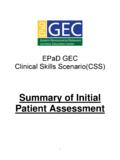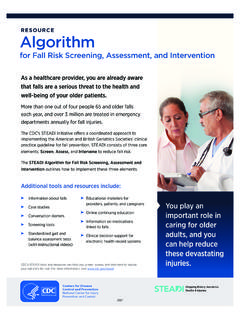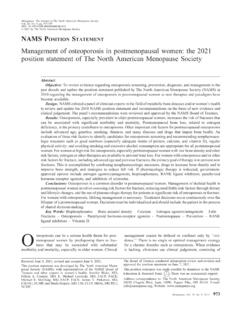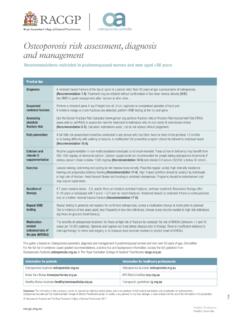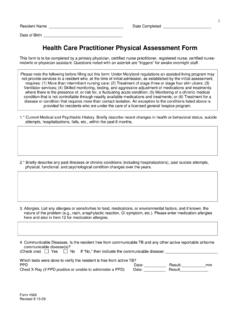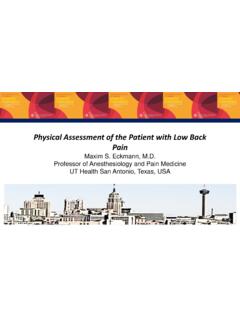Transcription of The Geriatric Assessment - AAFP Home
1 48 American Family Physician Volume 83, Number 1 January 1, 2011 The Geriatric AssessmentBASSEM ELSAWY, MD, and KIM E. HIGGINS, DO, Methodist Charlton Medical Center, Dallas, Texas Approximately one-half of the ambu- latory primary care for adults older than 65 years is provided by fam- ily physicians,1 and approximately 22 percent of visits to family physicians are from older ,3 It is estimated that older adults will comprise at least 30 percent of patients in typical family medicine outpa-tient practices, 60 percent in hospital prac-tices, and 95 percent in nursing home and home care complete Assessment is usually initiated when the physician detects a potential prob-lem such as confusion, falls, immobility, or incontinence. However, older persons often do not present in a typical manner, and atypi-cal responses to illness are common. A patient presenting with confusion may not have a neurologic problem, but rather an infec-tion. Social and psychological factors may also mask classic disease presentations.
2 For example, although 30 percent of adults older than 85 years have dementia, many physicians miss the ,6 Thus, a more structured approach to Assessment can be Geriatric Assessment is a multidimen-sional, multidisciplinary Assessment designed to evaluate an older person s functional ability, physical health, cognition and mental health, and socioenvironmental circumstances. It includes an extensive review of prescription and over-the-counter drugs, vitamins, and herbal products, as well as a review of immu-nization status. This Assessment aids in the diagnosis of medical conditions; development of treatment and follow-up plans; coordina-tion of management of care; and evaluation of long-term care needs and optimal Geriatric Assessment differs from a typical medical evaluation by including nonmedical domains; by emphasizing func-tional capacity and quality of life; and, often, by incorporating a multidisciplinary team including a physician, nutritionist, social worker, and physical and occupational ther-apists.
3 This type of Assessment often yields a more complete and relevant list of medical problems, functional problems, and psycho-social of the demands of a busy clinical practice, most Geriatric assessments tend to be less comprehensive and more problem-directed. For older patients with many con-cerns, the use of a rolling Assessment over several visits should be considered. The roll-ing Assessment targets at least one domain for screening during each office visit. Patient-driven Assessment instruments are also popular. Having patients complete question-naires and perform specific tasks not only saves time, but also provides useful insight into their motivation and cognitive Geriatric Assessment is a multidimensional, multidisciplinary Assessment designed to evaluate an older person s functional ability, physical health, cognition and mental health, and socioenvironmental circumstances. It is usually initiated when the physician identifies a potential problem. Specific elements of physical health that are evaluated include nutrition, vision, hearing, fecal and urinary continence, and balance.
4 The Geriatric Assessment aids in the diagnosis of medical conditions; development of treatment and follow-up plans; coordination of management of care; and evaluation of long-term care needs and optimal placement. The Geriatric Assessment differs from a stan-dard medical evaluation by including nonmedical domains; by emphasizing functional capacity and quality of life; and, often, by incorporating a multidisciplinary team. It usually yields a more complete and relevant list of medical problems, functional problems, and psychosocial issues. Well-validated tools and survey instruments for evaluating activities of daily living, hearing, fecal and urinary continence, balance, and cognition are an important part of the Geriatric Assessment . Because of the demands of a busy clinical practice, most Geriatric assessments tend to be less comprehensive and more problem-directed. When multiple concerns are presented, the use of a rolling assess-ment over several visits should be considered.
5 (Am Fam Physician. 2011;83(1):48-56. Copyright 2011 American Academy of Family Physicians.)DOWNLOADED FROM THE AMERICAN FAMILY PHYSICIAN WEB SITE AT COPYRIGHT 2010 AMERICAN ACADEMY OF FAMILY PHYSICIANS. FOR THE PRIVATE, NONCOMMERCIAL USE OF ONE INDIVIDUAL USER OF THE WEB SITE. ALL OTHER RIGHTS RESERVED. CONTACT FOR COPYRIGHT Geriatric AssessmentJanuary 1, 2011 Volume 83, Number 1 American Family Physician 49 Functional AbilityFunctional status refers to a person s ability to perform tasks that are required for living. The Geriatric Assessment begins with a review of the two key divisions of functional ability: activities of daily living (ADL) and instrumental activities of daily living (IADL). ADL are self-care activities that a person performs daily ( , eating, dressing, bath-ing, transferring between the bed and a chair, using the toilet, controlling bladder and bowel functions). IADL are activities that are needed to live independently ( , doing housework, preparing meals, taking medications properly, managing finances, using a telephone).
6 Physicians can acquire useful functional information by simply observ-ing older patients as they complete simple tasks, such as unbuttoning and buttoning a shirt, picking up a pen and writing a sentence, taking off and putting on shoes, and climbing up and down from an examination table. Two instruments for assessing ADL and IADL include the Katz ADL scale (Table 1)8 and the Lawton IADL scale (Table 2).9 Deficits in ADL and IADL can signal the need for more in-depth evaluation of the patient s socioenvironmental circumstances and the need for additional : KEY RECOMMENDATIONS FOR PRACTICEC linical recommendationEvidence ratingReferences The Preventive Services Task Force found insufficient evidence to recommend for or against screening with ophthalmoscopy in asymptomatic older 15 Patients with chronic otitis media or sudden hearing loss, or who fail any hearing screening tests should be referred to an , 23 Hearing aids are the treatment of choice for older patients with hearing impairment, because they minimize hearing loss and improve daily Preventive Services Task Force has advised routinely screening women 65 years and older for osteoporosis with dual-energy x-ray absorptiometry of the femoral Centers for Medicare and Medicaid Services encourages the use of the Beers criteria as part of an older patient s medication Assessment to reduce adverse , 40 A = consistent, good-quality patient-oriented evidence; B = inconsistent or limited-quality patient-oriented evidence.
7 C = consensus, disease-oriented evidence, usual practice, expert opinion, or case series. For information about the SORT evidence rating system, go to 1. Katz Index of Independence in Activities of Daily LivingActivities (1 or 0 points)Independence (1 point)* Dependence (0 points) BathingPoints: Bathes self completely or needs help in bathing only a single part of the body, such as the back, genital area, or disabled extremityNeeds help with bathing more than one part of the body, getting in or out of the bathtub or shower; requires total bathingDressingPoints: Gets clothes from closets and drawers, and puts on clothes and outer garments complete with fasteners; may need help tying shoesNeeds help with dressing self or needs to be completely dressedToiletingPoints: Goes to toilet, gets on and off, arranges clothes, cleans genital area without helpNeeds help transferring to the toilet and cleaning self, or uses bedpan or commodeTransferringPoints: Moves in and out of bed or chair unassisted.
8 Mechanical transfer aids are acceptableNeeds help in moving from bed to chair or requires a complete transferFecal and urinary continencePoints: Exercises complete self-control over urination and defecationIs partially or totally incontinent of bowel or bladderFeedingPoints: Gets food from plate into mouth without help; preparation of food may be done by another personNeeds partial or total help with feeding or requires parenteral feedingTotal points : * No supervision, direction, or personal assistance. With supervision, direction, personal assistance, or total care. Score of 6 = high (patient is independent); score of 0 = low (patient is very dependent). Adapted with permission from Katz S, Downs TD, Cash HR, Grotz RC. Progress in development of the index of ADL. Gerontologist. 1970;10(1) Assessment50 American Family Physician Volume 83, Number 1 January 1, 2011 Physical HealthThe Geriatric Assessment incorporates all fac-ets of a conventional medical history, includ-ing main problem, current illness, past and current medical problems, family and social history, demographic data, and a review of systems.
9 The approach to the history and physical examination, however, should be specific to older persons. In particular, top-ics such as nutrition, vision, hearing, fecal and urinary continence, balance and fall prevention, osteoporosis , and polypharmacy should be included in the evaluation. Table 3 is an example of a focused Geriatric physical FOR DISEASEIn the normal aging process, there is often a decline in physiologic function that is usu-ally not disease-related. However, treatment of diabetes mellitus, hypertension, and glau-coma can prevent significant future morbid-ity. Screening for malignancies may allow for early detection, and some are curable if treated early. It is important that physicians weigh the potential harms of screening before screening older patients. It is essential to consider family preferences regarding treat-ment if a disease is detected, and the patient s functional status, comorbid conditions, and predicted life expectancy. If an asymptom-atic patient has an expected survival of more than five years, screening is generally medi-cally warranted, assuming that the patient is at risk of the disease and would accept treat-ment if early disease was ,11 The Agency for Healthcare Research and Quality has developed an online tool called the Electronic Preventive Services Selec-tor ( ) that can be downloaded to smartphones.
10 It can assist physicians in identifying age- appropriate screening nutritional Assessment is important because inadequate micronutrient intake is common in older persons. Several age-related medical conditions may predispose patients to vitamin and mineral deficiencies. Studies have shown that vitamins A, C, D, Table 2. Lawton Instrumental Activities of Daily Living Scale (Self-Rated Version)For each question, circle the points for the answer that best applies to your situation. 1. Can you use the telephone? Without help With some help Completely unable to use the telephone321 2. Can you get to places that are out of walking distance? Without help With some help Completely unable to travel unless special arrangements are made321 3. Can you go shopping for groceries? Without help With some help Completely unable to do any shopping321 4. Can you prepare your own meals? Without help With some help Completely unable to prepare any meals321 5. Can you do your own housework?










